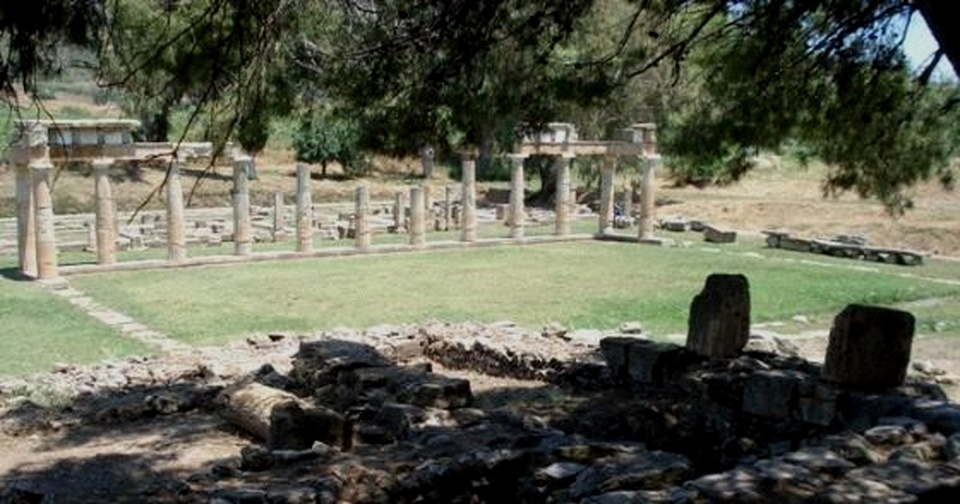Ursa Major-Spring Equinox
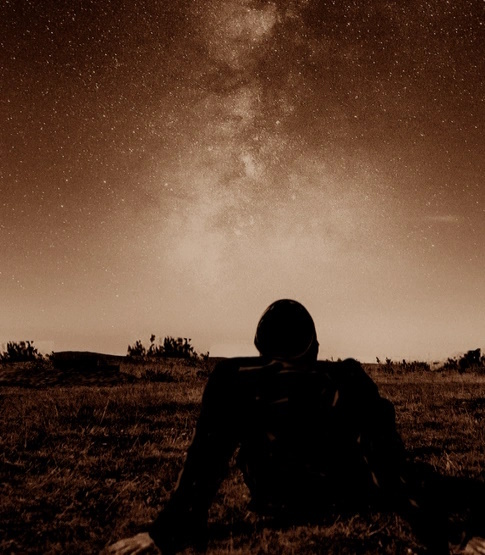
Stargazing
We are the universe experiencing itself. Alan Watts
A meditation, particularly in the Bon and Buddhist traditions. The practice starts by allowing your eyes to adapt to the darkness of night then observing the sky, keeping your eyes still. You fix your gaze and focus on space.
Sit or lie down and settle your breathing. Be aware of your outward breath. Rest your gaze on the sky or horizon, and just breathe regularly and normally. Be aware of your breathing without forcing it. Notice that the sky you are seeing is at one with your mind, that they can connect. The sky above is mirrored by your inner sky of the mind. You are 'in the moment'.
There's nothing to do but stop, watch and if you do have emotions, etc. which you wish to release, you can dissolve them in the open sky.
You are not thinking about the stars, just aware. You may notice they form patterns. That some stars are brighter than others. Let these thoughts arise then pass.
If you are having difficulty achieving this one practice is to stretch out your arm and look at your index finger. Once you are comfortable and settled lower your arm and maintain the gaze. You just keep repeating this process until focusing in space becomes easier. Full explanation of Sky Gazing
| Sir Walter Scott's 1805 verse "Lay of the Last Minstrel" | Erasamus Darwin |
| Arthur's slow wain his course doth roll, In utter darkness round the pole; The Northern Bear lowers black and grim; Orion's studded belt is dim; Twinkling faint, and distant far, Shimmers through mist each planet star, Ill may I read their high decree! | Onward the kindred Bears, with footsteps rude, Dance round the pole, pursuing and pursued. |
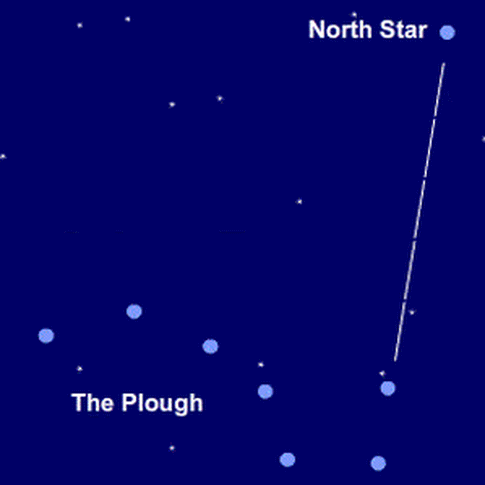
Ursa Major is always above the horizon
in the northern latitudes around the Pole (aka North) Star. But the best time to see it is in the
spring when it is revolving high overhead, above the north eastern horizon. A collection of
seven stars, many names have been attached to this grouping, depending on where you live and what period of history you live in.
Grimm in Teutonic Mythology suggests that it might originally have been Woden's wagon. The Plough is from about the 1400s in Britain and Big Dipper used by Americans. The pattern of stars brings to mind a farm wagon and is easy to see with four stars as the 'box' and three as the pole. Known in Ireland and Wales as Arthur’s Wain (possibly after King Arthur legends) or in Europe as Charle's Wain, the Charles said to be associated with Charlemagne.
Sapta rishi in Sanskrit, the seven stars are considered as seven great sages, appearing throughout Vedic and Hindu texts.
As it lies in the north it seems the Greeks linked that area to the bear, though it must be said the stars hardly resemble a bear in shape. However, many North American tribes in the northeast had long seen the seven-star group as a bear tracked by three hunters, or a hunter and his two dogs.
Bears are connected to the modern name McMahon. McMahons of Monaghan - Irish word math = matus, “bear.”
It is Mac-Mathghamhna, written today with the English spelling Mac Mahon, the name of a very widespread family who we find for the first time in the Annals of the Four Masters in 1283. This name means “son of the bear cub.”
There is an ancient Celtic myth about the sleeping bear gods who will rise from hibernation and come to the aid of their people when called.
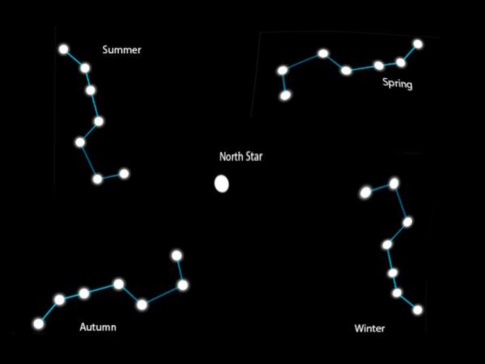
The Four Directions:
With the energies of the East, and of Spring, our bear goddess awakes, reminds us that life is wonder-full, that with the potential of new beginnings, and new journeys, there will be challenges.
With the energies of the South, and of Summer, our bear goddess thrives, reminds us to live with joy, enthusiasm and trust.
With the energies of the West, and of Autumn, our bear goddess reminds us to live, love and nurture each other with the bounty of nature and with love.
With the energies of the North, and of Winter, our bear goddess reminds us to relax, release and let go of hustle, labour and physical activity, and to draw on our inner wisdom.
Navigation:
Suppose one night you play a game with your friend who is far away from your sight, perhaps, a few hundred miles away. You ask him to specify the star which is directly above his site, then you try to observe that star in the night sky above your head. Now the point on the horizon directly below that star would be somehow their position from you at the given moment.
But as you know every stellar object is always in motion, sadly, that star would have moved away a few minutes later. Now you would need a new star to identify your friend, hence this method appears to be not so convincing. Luckily, there exists a star that does not seem to walk, it is named Polaris, the north star.
A useful link exploring navigation and the stars can be found here
Time Keeping:
Because Earth has a daily rotation around it's axis it seems as if stars close to the celestial poles revolve around that pivot point once each day. Thus constellations and stars close to the celestial poles, such as the Big Dipper, can be used to estimate time during the night.
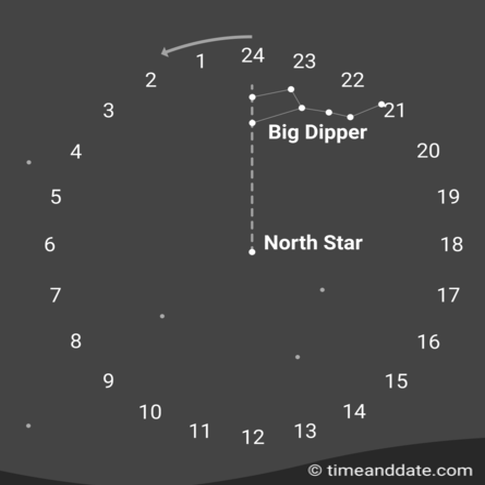
A Counter-Clockwise Star Clock
- Use Ursa Major to find the North Star (Polaris).
- Now, picture a clock with the
North Star at its centre. Remember that Ursa Major revolves around the North Star every 24 hours.
- Draw an imaginary line starting from
the North Star through the 2 pointer stars of Ursa Major –
Dubhe and Merak.
- Assume that this is the hour hand of your imaginary star clock. The clock is a 24-hour clock. The hour hand moves 15 degrees per hour and turns counter-clockwise.
- Draw another imaginary line straight up from the North Star. This line will mark midnight or the passing of 24 hours.
Archaeological sites:
Group of 3 sandstone bear statues found at Armagh, Northern Ireland - smallest now missing.
Sandstone figures of bears dating to pre-5th c. BC, have also been unearthed in Ireland, during the rebuilding of the Armagh Cathedral in 1840.[5] It’s well-known that the Church often built directly upon pagan temples, as a means of converting the non-Christians. Pagan bear statues in Armagh
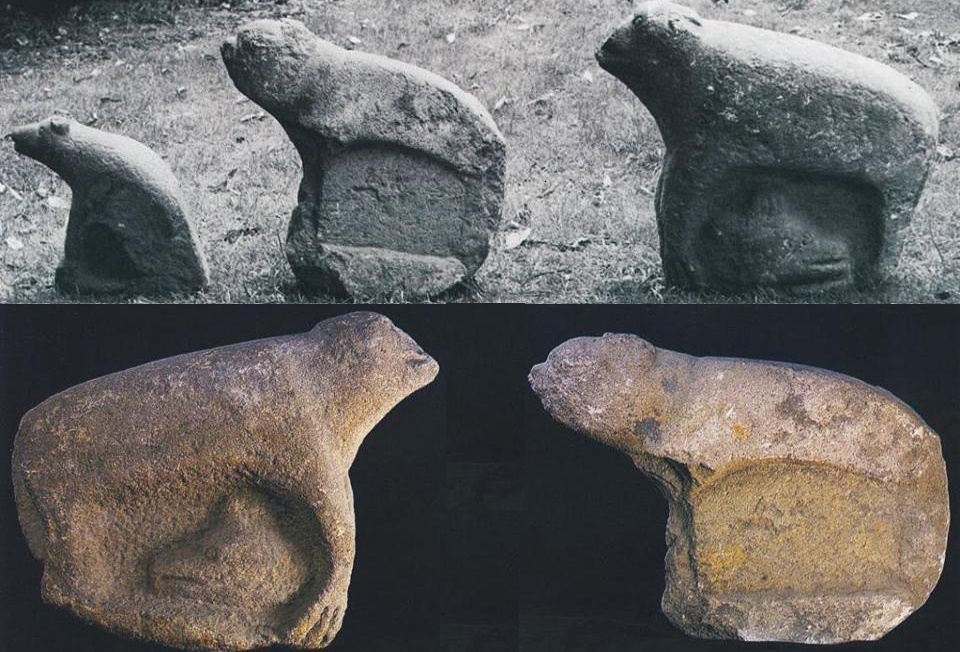
Ursa Major Stone, Brae of Cultullich, Aberfeldy, Perthshire - Fascinating cup stone in Scotland noted in the Northern Antiquarian.
As can be seen quite clearly, the cups are arranged in the shape of the constellation of the Great Bear, or Ursa Major – albeit with an extra ‘star’ in this design. But it’s damn close! In all likelihood (he says with his sceptical head on ), the design is fortuitous when it comes to the Ursa Major. I know from many years experience how easy it is to see meaningful shapes and designs in the almost entirely abstract British petroglyphs, but the design is very close to the constellation we all got to know when we were kids.
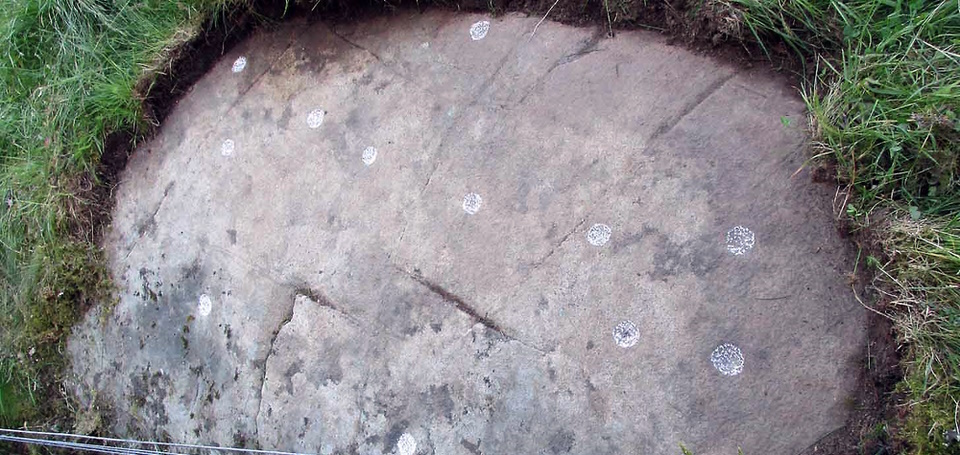
Heavenly Gates in Negev Desert Rock Art, Israel Israeli Rock Art of 3 Realms
John C. Didier (2009) posits that the concept of a celestial gate is formed by the stars surrounding the North Pole. This includes the constellations of Ursa Major, Ursa Minor, and Draco in close proximity to the North Star (as depicted in Fig. 2). The top of the gate is defined by the two stars of Ursa Minor, while the bottom is demarcated by the two stars of Ursa Major. The connecting lines between these four stars form a rectangular gate that encompasses Thuban, a star located in the tail of the Draco constellation. Around 4000 years ago, Thuban was the North Pole star and the center of the earth’s rotation. This imagery of the gate being carried by the bull, which symbolizes Ursa Major, harkens back to the ancient belief that this constellation was the
entryway to paradise.
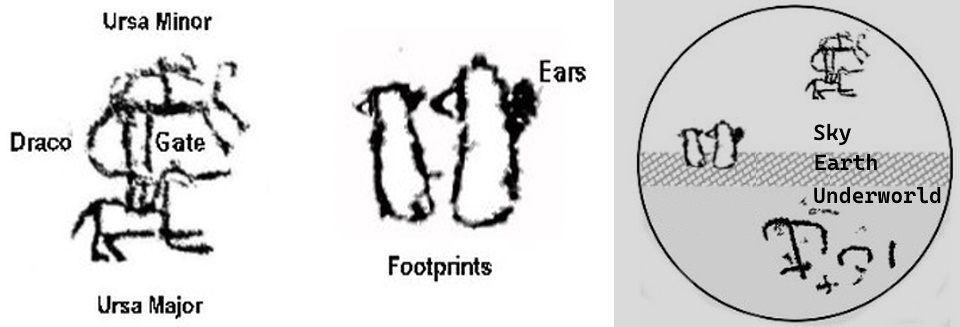
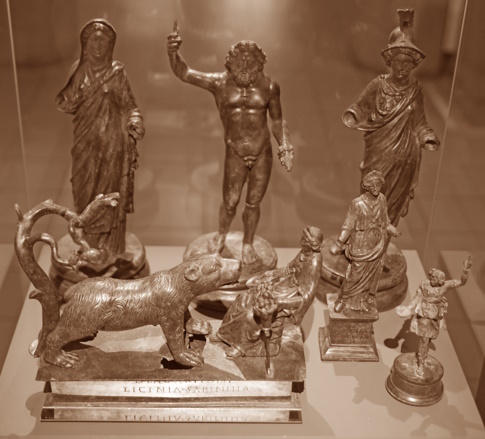
Artha / Artio and Artaois
One of the attributes of Ursa Major is
as Artha, the Goddess of Springtime, and more precisely of Spring
Equinox. She has been depicted as a star maiden, holding light and
dark in balance. She leads us out of our winter caves, blessing us
with the courage to move forward into life.
The bear is felt to be one of the oldest deities as the skulls and bones of bears have been found arranged in a ceremonial fashion in caves. A 70,000-year-old grave from the Paleolithic period was discovered in France. The grave was lined with a bearskin and bear bones were arranged around the human body.
from 'Celebrate Pagan Holidays' . com
Relics of the bear goddess, of the Celtic tribes, Artio, are notably the statuette in Muri, near Bern in Switzerland. The bear comes out of the woods with the goddess sitting. The Celts seem to have believed that she offered protection, like a mother bear.
In the spring, as the asterism Ursa Major, she appears standing upright, her paws up high, her body the 'bowl' inverted. She is showing us the way, she guides us with her strength and courage.
The two Celtic bear gods are mentioned in inscriptions across Europe, mainly France, Germany and Switzerland. Artaois is linked to the warrior-king, Arthur, by name and also the Roman god Mercury from an inscription in France - ‘the august Mercury Artaius’.
Greek Brauronia Festival
The ancient Greek word for bear is arktos, the derivation of star name Arcturus, meaning "guardian of the bear", from its position behind the tail of Ursa Major, and arctic, north, again a reference to the northern constellation of the bear. The Greek bear goddess was Callisto. There are various versions of her myth and she is transformed into a bear and turned into a constellation in many of them.
One festival linking to bears in the Brauronia. This is said to date from as early as the Neolithic and might have been an annual event. By the 5th century The Great Brauronia Festival took place every four years. A procession went from the Acropolis in Athens to the town of Brauron. Here there was music, athletic games, feasting and horse racing.
As soon as I was seven I was an arrhephoros (sacred basket carrier). Then at ten I was an aletris (miller of corn) for the foundress, and shedding my saffron robe I was an arktos (bear) at the Brauronia.
Aristophanes Lysistrata, lines 641-647.
The dance, also called the "arkteia", was made up of slow, solemn steps meant to imitate the movements of a bear and was performed to a tune from a diaulos (double flute).
